Solar eclipse
coronal streamers. | |
 An annular solar eclipse occurs when the Moon is too far away to completely cover the Sun's disk (October 14, 2023). | |
 During a partial solar eclipse, the Moon blocks only part of the Sun's disk (October 25, 2022 ). |
A solar eclipse occurs when the Moon passes between Earth and the Sun, thereby obscuring the view of the Sun from a small part of Earth, totally or partially. Such an alignment occurs approximately every six months, during the eclipse season in its new moon phase, when the Moon's orbital plane is closest to the plane of Earth's orbit.[1] In a total eclipse, the disk of the Sun is fully obscured by the Moon. In partial and annular eclipses, only part of the Sun is obscured. Unlike a lunar eclipse, which may be viewed from anywhere on the night side of Earth, a solar eclipse can only be viewed from a relatively small area of the world. As such, although total solar eclipses occur somewhere on Earth every 18 months on average, they recur at any given place only once every 360 to 410 years.
If the Moon were in a perfectly circular orbit and in the same orbital plane as Earth, there would be total solar eclipses once a month, at every new moon. Instead, because the Moon's orbit is
An eclipse is a natural phenomenon. In some ancient and modern cultures, solar eclipses were attributed to supernatural causes or regarded as bad omens. Astronomers' predictions of eclipses began in China as early as the 4th century BC; eclipses hundreds of years into the future may now be predicted with high accuracy.
Looking directly at the Sun can lead to permanent eye damage, so special eye protection or indirect viewing techniques are used when viewing a solar eclipse. Only the total phase of a total solar eclipse is safe to view without protection. Enthusiasts known as eclipse chasers or umbraphiles travel to remote locations to see solar eclipses.[4][5]
Types

The Sun's distance from Earth is about 400 times the Moon's distance, and the Sun's
The Moon's orbit around Earth is slightly
Because Earth's orbit around the Sun is also elliptical, Earth's distance from the Sun similarly varies throughout the year. This affects the apparent size of the Sun in the same way, but not as much as does the Moon's varying distance from Earth.
There are three main types of solar eclipses:[10]
Total eclipse
A total eclipse occurs on average every 18 months
Annular eclipse
An annular eclipse, like a total eclipse, occurs when the Sun and Moon are exactly in line with Earth. During an annular eclipse, however, the apparent size of the Moon is not large enough to completely block out the Sun.
Partial eclipse
A partial eclipse occurs about twice a year,

Terminology
Hybrid eclipse
A hybrid eclipse (also called annular/total eclipse) shifts between a total and annular eclipse. At certain points on the surface of Earth, it appears as a total eclipse, whereas at other points it appears as annular. Hybrid eclipses are comparatively rare.[6]
A hybrid eclipse occurs when the magnitude of an eclipse changes during the event from less to greater than one, so the eclipse appears to be total at locations nearer the midpoint, and annular at other locations nearer the beginning and end, since the sides of Earth are slightly further away from the Moon. These eclipses are extremely narrow in their path width and relatively short in their duration at any point compared with fully total eclipses; the 2023 April 20 hybrid eclipse's totality is over a minute in duration at various points along the path of totality. Like a focal point, the width and duration of totality and annularity are near zero at the points where the changes between the two occur.[16]
Central eclipse
Central eclipse is often used as a generic term for a total, annular, or hybrid eclipse.[17] This is, however, not completely correct: the definition of a central eclipse is an eclipse during which the central line of the umbra touches Earth's surface. It is possible, though extremely rare, that part of the umbra intersects with Earth (thus creating an annular or total eclipse), but not its central line. This is then called a non-central total or annular eclipse.[17] Gamma is a measure of how centrally the shadow strikes. The last (umbral yet) non-central solar eclipse was on April 29, 2014. This was an annular eclipse. The next non-central total solar eclipse will be on April 9, 2043.[18]
Eclipse phases
The visual phases observed during a total eclipse are called:[19]
- First contact—when the Moon's limb (edge) is exactly tangential to the Sun's limb.
- Second contact—starting with diamond ring effect. Almost the entire disk is covered.
- Totality—the Moon obscures the entire disk of the Sun and only the solar corona is visible.
- Third contact—when the first bright light becomes visible and the Moon's shadow is moving away from the observer. Again a diamond ring may be observed.
- Fourth contact—when the trailing edge of the Moon ceases to overlap with the solar disk and the eclipse ends.
Predictions
Geometry
The Moon's orbit around Earth is inclined at an angle of just over 5 degrees to the plane of Earth's orbit around the Sun (the ecliptic). Because of this, at the time of a new moon, the Moon will usually pass to the north or south of the Sun. A solar eclipse can occur only when a new moon occurs close to one of the points (known as nodes) where the Moon's orbit crosses the ecliptic.[21]
As noted above, the Moon's orbit is also
| Moon | Sun | |||
|---|---|---|---|---|
| At perigee (nearest) |
At apogee (farthest) |
At perihelion (nearest) |
At aphelion (farthest) | |
| Mean radius | 1737.10 km (1079.38 mi) |
696000 km (432000 mi) | ||
| Distance | 363104 km (225622 mi) |
405696 km (252088 mi) |
147098070 km (91402500 mi) |
152097700 km (94509100 mi) |
| Angular diameter[24] |
33' 30" (0.5583°) |
29' 26" (0.4905°) |
32' 42" (0.5450°) |
31' 36" (0.5267°) |
| Apparent size to scale |

|

|

|

|
| Order by decreasing apparent size |
1st | 4th | 2nd | 3rd |
The Moon orbits Earth in approximately 27.3 days, relative to a
The Moon crosses from south to north of the ecliptic at its
Finally, the Moon's perigee is moving forwards or precessing in its orbit and makes a complete circuit in 8.85 years. The time between one perigee and the next is slightly longer than the sidereal month and known as the
The Moon's orbit intersects with the ecliptic at the two nodes that are 180 degrees apart. Therefore, the new moon occurs close to the nodes at two periods of the year approximately six months (173.3 days) apart, known as eclipse seasons, and there will always be at least one solar eclipse during these periods. Sometimes the new moon occurs close enough to a node during two consecutive months to eclipse the Sun on both occasions in two partial eclipses. This means that, in any given year, there will always be at least two solar eclipses, and there can be as many as five.[27]
Eclipses can occur only when the Sun is within about 15 to 18 degrees of a node, (10 to 12 degrees for central eclipses). This is referred to as an eclipse limit, and is given in ranges because the apparent sizes and speeds of the Sun and Moon vary throughout the year. In the time it takes for the Moon to return to a node (draconic month), the apparent position of the Sun has moved about 29 degrees, relative to the nodes.[2] Since the eclipse limit creates a window of opportunity of up to 36 degrees (24 degrees for central eclipses), it is possible for partial eclipses (or rarely a partial and a central eclipse) to occur in consecutive months.[28][29]

Path

During a central eclipse, the Moon's umbra (or antumbra, in the case of an annular eclipse) moves rapidly from west to east across Earth. Earth is also rotating from west to east, at about 28 km/min at the Equator, but as the Moon is moving in the same direction as Earth's rotation at about 61 km/min, the umbra almost always appears to move in a roughly west–east direction across a map of Earth at the speed of the Moon's orbital velocity minus Earth's rotational velocity.[31]
The width of the track of a central eclipse varies according to the relative apparent diameters of the Sun and Moon. In the most favourable circumstances, when a total eclipse occurs very close to perigee, the track can be up to 267 km (166 mi) wide and the duration of totality may be over 7 minutes.[32] Outside of the central track, a partial eclipse is seen over a much larger area of Earth. Typically, the umbra is 100–160 km wide, while the penumbral diameter is in excess of 6400 km.[33]
Besselian elements are used to predict whether an eclipse will be partial, annular, or total (or annular/total), and what the eclipse circumstances will be at any given location.[34]: Chapter 11
Calculations with Besselian elements can determine the exact shape of the umbra's shadow on Earth's surface. But at what longitudes on Earth's surface the shadow will fall, is a function of Earth's rotation, and on how much that rotation has slowed down over time. A number called ΔT is used in eclipse prediction to take this slowing into account. As Earth slows, ΔT increases. ΔT for dates in the future can only be roughly estimated because Earth's rotation is slowing irregularly. This means that, although it is possible to predict that there will be a total eclipse on a certain date in the far future, it is not possible to predict in the far future exactly at what longitudes that eclipse will be total. Historical records of eclipses allow estimates of past values of ΔT and so of Earth's rotation. [34]: Equation 11.132
Duration
The following factors determine the duration of a total solar eclipse (in order of decreasing importance):[35][36]
- The Moon being almost exactly at perigee (making its angular diameter as large as possible).
- Earth being very near aphelion (furthest away from the Sun in its elliptical orbit, making its angular diameter nearly as small as possible).
- The midpoint of the eclipse being very close to Earth's equator, where the rotational velocity is greatest and is closest to the speed of the lunar shadow moving over Earth's surface.
- The vector of the eclipse path at the midpoint of the eclipse aligning with the vector of Earth's rotation (i.e. not diagonal but due east).
- The midpoint of the eclipse being near the subsolar point (the part of Earth closest to the Sun).
The longest eclipse that has been calculated thus far is the eclipse of July 16, 2186 (with a maximum duration of 7 minutes 29 seconds over northern Guyana).[35]
Occurrence and cycles

A total solar eclipse is a rare event, recurring somewhere on Earth every 18 months on average,
It is possible to predict other eclipses using
Frequency per year
Between two and five solar eclipses occur every year, with at least one per eclipse season. Since the Gregorian calendar was instituted in 1582, years that have had five solar eclipses were 1693, 1758, 1805, 1823, 1870, and 1935. The next occurrence will be 2206.[45] On average, there are about 240 solar eclipses each century.[46]
January 5
|
February 3 | June 30 | July 30
|
December 25 |
|---|---|---|---|---|
| Partial (south) |
Partial (north) |
Partial (north) |
Partial (south) |
Annular (south) |
 Saros 111 |
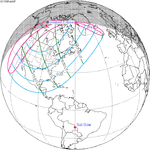 Saros 149 |
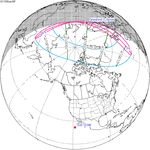 Saros 116 |
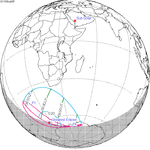 Saros 154 |
 Saros 121 |
Final totality
Total solar eclipses are seen on Earth because of a fortuitous combination of circumstances. Even on Earth, the diversity of eclipses familiar to people today is a temporary (on a geological time scale) phenomenon. Hundreds of millions of years in the past, the Moon was closer to Earth and therefore apparently larger, so every solar eclipse was total or partial, and there were no annular eclipses. Due to tidal acceleration, the orbit of the Moon around Earth becomes approximately 3.8 cm more distant each year. Millions of years in the future, the Moon will be too far away to fully occlude the Sun, and no total eclipses will occur. In the same timeframe, the Sun may become brighter, making it appear larger in size.[47] Estimates of the time when the Moon will be unable to occlude the entire Sun when viewed from Earth range between 650 million[48] and 1.4 billion years in the future.[47]
Viewing
Looking directly at the
Under normal conditions, the Sun is so bright that it is difficult to stare at it directly. However, during an eclipse, with so much of the Sun covered, it is easier and more tempting to stare at it. Looking at the Sun during an eclipse is as dangerous as looking at it outside an eclipse, except during the brief period of totality, when the Sun's disk is completely covered (totality occurs only during a total eclipse and only very briefly; it does not occur during a partial or annular eclipse). Viewing the Sun's disk through any kind of optical aid (binoculars, a telescope, or even an optical camera viewfinder) is extremely hazardous and can cause irreversible eye damage within a fraction of a second.[51][52]
Partial and annular eclipses
Viewing the Sun during partial and annular eclipses (and during total eclipses outside the brief period of totality) requires special eye protection, or indirect viewing methods if eye damage is to be avoided. The Sun's disk can be viewed using appropriate filtration to block the harmful part of the Sun's radiation. Sunglasses do not make viewing the Sun safe. Only properly designed and certified solar filters should be used for direct viewing of the Sun's disk.
The safest way to view the Sun's disk is by indirect projection.[56] This can be done by projecting an image of the disk onto a white piece of paper or card using a pair of binoculars (with one of the lenses covered), a telescope, or another piece of cardboard with a small hole in it (about 1 mm diameter), often called a pinhole camera. The projected image of the Sun can then be safely viewed; this technique can be used to observe sunspots, as well as eclipses. Care must be taken, however, to ensure that no one looks through the projector (telescope, pinhole, etc.) directly.[57] A kitchen colander with small holes can also be used to project multiple images of the partially eclipsed Sun onto the ground or a viewing screen. Viewing the Sun's disk on a video display screen (provided by a video camera or digital camera) is safe, although the camera itself may be damaged by direct exposure to the Sun. The optical viewfinders provided with some video and digital cameras are not safe. Securely mounting #14 welder's glass in front of the lens and viewfinder protects the equipment and makes viewing possible.[55] Professional workmanship is essential because of the dire consequences any gaps or detaching mountings will have. In the partial eclipse path, one will not be able to see the corona or nearly complete darkening of the sky. However, depending on how much of the Sun's disk is obscured, some darkening may be noticeable. If three-quarters or more of the Sun is obscured, then an effect can be observed by which the daylight appears to be dim, as if the sky were overcast, yet objects still cast sharp shadows.[58]
Totality
When the shrinking visible part of the photosphere becomes very small,
It is safe to observe the total phase of a solar eclipse directly only when the Sun's photosphere is completely covered by the Moon, and not before or after totality.
Eclipse chasing
A dedicated group of eclipse chasers have pursued the observation of solar eclipses when they occur around Earth.[60] A person who chases eclipses is known as an umbraphile, meaning shadow lover.[61] Umbraphiles travel for eclipses and use various tools to help view the sun including solar viewing glasses, also known as eclipse glasses, as well as telescopes.[62][63]
Photography

The first known photograph of a solar eclipse was taken on July 28, 1851, by Johann Julius Friedrich Berkowski, using the daguerreotype process.[64][65]
Photographing an eclipse is possible with fairly common camera equipment. In order for the disk of the Sun/Moon to be easily visible, a fairly high magnification
Historical eclipses

Historical eclipses are a very valuable resource for historians, in that they allow a few historical events to be dated precisely, from which other dates and ancient calendars may be deduced.[68] The oldest recorded solar eclipse was recorded on a clay tablet found at Ugarit, in modern Syria, with two plausible dates usually cited: 3 May 1375 BC or 5 March 1223 BC, the latter being favored by most recent authors on the topic.[69][70] A solar eclipse of June 15, 763 BC mentioned in an Assyrian text is important for the chronology of the ancient Near East.[71] There have been other claims to date earlier eclipses. The legendary Chinese king Zhong Kang supposedly beheaded two astronomers, Hsi and Ho, who failed to predict an eclipse 4000 years ago.[72] Perhaps the earliest still-unproven claim is that of archaeologist Bruce Masse, who putatively links an eclipse that occurred on May 10, 2807, BC with a possible meteor impact in the Indian Ocean on the basis of several ancient flood myths that mention a total solar eclipse.[73]

Eclipses have been interpreted as
In ancient China, where solar eclipses were known as an "eating of the Sun" (rìshí 日食), the earliest records of eclipses date to around 720 BC.[82] The 4th century BC astronomer Shi Shen described the prediction of eclipses by using the relative positions of the Moon and Sun.[83]
Attempts have been made to establish the exact date of
A

The first known telescopic observation of a total solar eclipse was made in France in 1706.
John Fiske summed up myths about the solar eclipse like this in his 1872 book Myth and Myth-Makers,
the myth of Hercules and Cacus, the fundamental idea is the victory of the solar god over the robber who steals the light. Now whether the robber carries off the light in the evening when Indra has gone to sleep, or boldly rears his black form against the sky during the daytime, causing darkness to spread over the earth, would make little difference to the framers of the myth. To a chicken a solar eclipse is the same thing as nightfall, and he goes to roost accordingly. Why, then, should the primitive thinker have made a distinction between the darkening of the sky caused by black clouds and that caused by the rotation of the earth? He had no more conception of the scientific explanation of these phenomena than the chicken has of the scientific explanation of an eclipse. For him it was enough to know that the solar radiance was stolen, in the one case as in the other, and to suspect that the same demon was to blame for both robberies.[89]
Particular observations, phenomena and impact
A total solar eclipse provides a rare opportunity to observe the
Phenomena associated with eclipses include shadow bands (also known as flying shadows), which are similar to shadows on the bottom of a swimming pool. They occur only just prior to and after totality, when a narrow solar crescent acts as an anisotropic light source.[91] As the light filters through leaves of trees during a partial eclipse, the overlapping leaves create natural pinholes, displaying mini eclipses on the ground.[92]
1919 observations

The observation of a total solar eclipse of May 29, 1919, helped to confirm Einstein's theory of general relativity. By comparing the apparent distance between stars in the constellation Taurus, with and without the Sun between them, Arthur Eddington stated that the theoretical predictions about gravitational lenses were confirmed.[93] The observation with the Sun between the stars was possible only during totality since the stars are then visible. Though Eddington's observations were near the experimental limits of accuracy at the time, work in the later half of the 20th century confirmed his results.[94][95]
Gravity anomalies
There is a long history of observations of gravity-related phenomena during solar eclipses, especially during the period of totality. In 1954, and again in 1959, Maurice Allais reported observations of strange and unexplained movement during solar eclipses.[96] The reality of this phenomenon, named the Allais effect, has remained controversial. Similarly, in 1970, Saxl and Allen observed the sudden change in motion of a torsion pendulum; this phenomenon is called the Saxl effect.[97]
Observation during the 1997 solar eclipse by Wang et al. suggested a possible gravitational shielding effect,[98] which generated debate. In 2002, Wang and a collaborator published detailed data analysis, which suggested that the phenomenon still remains unexplained.[99]
Eclipses and transits
In principle, the simultaneous occurrence of a solar eclipse and a transit of a planet is possible. But these events are extremely rare because of their short durations. The next anticipated simultaneous occurrence of a solar eclipse and a transit of Mercury will be on July 5, 6757, and a solar eclipse and a transit of Venus is expected on April 5, 15232.[100]
More common, but still infrequent, is a
Artificial satellites


Artificial satellites can also pass in front of the Sun as seen from Earth, but none is large enough to cause an eclipse. At the altitude of the International Space Station, for example, an object would need to be about 3.35 km (2.08 mi) across to blot the Sun out entirely. These transits are difficult to watch because the zone of visibility is very small. The satellite passes over the face of the Sun in about a second, typically. As with a transit of a planet, it will not get dark.[102]
Observations of eclipses from spacecraft or artificial satellites orbiting above Earth's atmosphere are not subject to weather conditions. The crew of Gemini 12 observed a total solar eclipse from space in 1966.[103] The partial phase of the 1999 total eclipse was visible from Mir.[104]
Impact
The
Eclipses may cause the temperature to decrease by 3 °C (5 °F), with wind power potentially decreasing as winds are reduced by 0.7 meters (2.3 ft) per second.[107]
In addition to the drop in light level and air temperature, animals change their behavior during totality. For example, birds and squirrels return to their nests and crickets chirp.[108]
Recent and forthcoming solar eclipses

Eclipses occur only in the
1997–2000
This eclipse is a member of a semester series. An eclipse in a semester series of solar eclipses repeats approximately every 177 days and 4 hours (a semester) at alternating nodes of the Moon's orbit.[109]
| Descending node | Ascending node | |||||
|---|---|---|---|---|---|---|
| Saros | Map | Gamma | Saros | Map | Gamma | |
120 Chita, Russia |
1997 March 09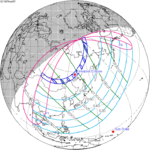 Total |
0.91830 | 125 | 1997 September 02 Partial (south) |
−1.03521 | |
130 Total eclipse near Guadeloupe |
1998 February 26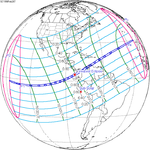 Total |
0.23909 | 135 | 1998 August 22 Annular |
−0.26441 | |
| 140 | 1999 February 16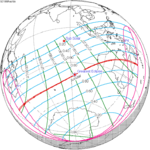 Annular |
−0.47260 | 145 Totality from France |
1999 August 11 Total |
0.50623 | |
| 150 | 2000 February 05 Partial (south) |
−1.22325 | 155 | 2000 July 31 Partial (north) |
1.21664 | |
Partial solar eclipses on July 1, 2000 and December 25, 2000 occur in the next lunar year eclipse set.
2000–2003
This eclipse is a member of a semester series. An eclipse in a semester series of solar eclipses repeats approximately every 177 days and 4 hours (a semester) at alternating nodes of the Moon's orbit.[110]
Partial solar eclipses on February 5, 2000 and July 31, 2000 occur in the previous lunar year set.
| Ascending node | Descending node | |||||
|---|---|---|---|---|---|---|
| Saros | Map | Gamma | Saros | Map | Gamma | |
| 117 | 2000 July 01 Partial (south) |
−1.28214 | 122 | 2000 December 25 Partial (north) |
1.13669 | |
| 127 Lusaka, Zambia
|
2001 June 21 Total |
−0.57013 | 132 Minneapolis, MN
|
2001 December 14 Annular |
0.40885 | |
| 137 Los Angeles, CA
|
2002 June 10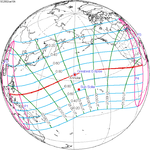 Annular |
0.19933 | 142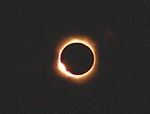 Totality from Woomera |
2002 December 04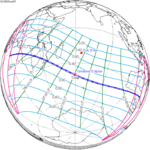 Total |
−0.30204 | |
| 147 Culloden, Scotland
|
2003 May 31 Annular |
0.99598 | 152 | 2003 November 23 Total |
−0.96381 | |
2004–2007
This eclipse is a member of a semester series. An eclipse in a semester series of solar eclipses repeats approximately every 177 days and 4 hours (a semester) at alternating nodes of the Moon's orbit.[111]
| Ascending node | Descending node | |||||
|---|---|---|---|---|---|---|
| Saros | Map | Gamma | Saros | Map | Gamma | |
| 119 | 2004 April 19 Partial (south) |
−1.13345 | 124 | 2004 October 14 Partial (north) |
1.03481 | |
129 Partial from Naiguatá |
2005 April 08 Hybrid |
−0.34733 | 134 Annular from Madrid, Spain |
2005 October 03 Annular |
0.33058 | |
139 Total from Side, Turkey |
2006 March 29 Total |
0.38433 | 144 Partial from São Paulo, Brazil |
2006 September 22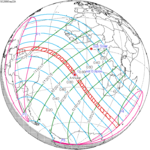 Annular |
−0.40624 | |
149 From Jaipur, India |
2007 March 19 Partial (north) |
1.07277 | 154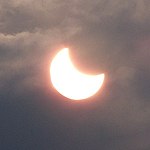 From Córdoba, Argentina |
2007 September 11 Partial (south) |
−1.12552 | |
2008–2011
This eclipse is a member of a semester series. An eclipse in a semester series of solar eclipses repeats approximately every 177 days and 4 hours (a semester) at alternating nodes of the Moon's orbit.[112]
| Ascending node | Descending node | |||||
|---|---|---|---|---|---|---|
| Saros | Map | Gamma | Saros | Map | Gamma | |
121 Partial from Christchurch, NZ |
2008 February 07 Annular |
−0.95701 | 126 Novosibirsk, Russia
|
2008 August 01 Total |
0.83070 | |
131 Palangka Raya, Indonesia |
2009 January 26 Annular |
−0.28197 | 136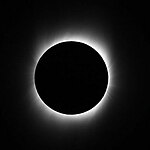 Kurigram, Bangladesh |
2009 July 22 Total |
0.06977 | |
| 141 Bangui, Central African Republic
|
2010 January 15 Annular |
0.40016 | 146 Hao, French Polynesia
|
2010 July 11 Total |
−0.67877 | |
| 151 Vienna, Austria
|
2011 January 04 Partial (north) |
1.06265 | 156 | 2011 July 01 Partial (south) |
−1.49171 | |
Partial solar eclipses on June 1, 2011, and November 25, 2011, occur on the next lunar year eclipse set.
2011–2014
This eclipse is a member of the 2011–2014 solar eclipse semester series. An eclipse in a semester series of solar eclipses repeats approximately every 177 days and 4 hours (a semester) at alternating nodes of the Moon's orbit.[113][Note 1]
| Descending node | Ascending node | |||||
|---|---|---|---|---|---|---|
| Saros | Map | Gamma | Saros | Map | Gamma | |
118 Partial from Tromsø, Norway |
2011 June 01 Partial (north) |
1.21300 | 123 Hinode XRT footage |
2011 November 25 Partial (south) |
−1.05359 | |
128 Middlegate, Nevada |
2012 May 20 Annular |
0.48279 | 133 Cairns, Australia |
2012 November 13 Total |
−0.37189 | |
138 Churchills Head, Australia |
2013 May 10 Annular |
−0.26937 | 143 Libreville, Gabon
|
2013 November 03 Hybrid |
0.32715 | |
148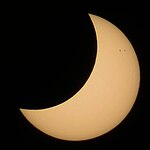 Partial from Adelaide, Australia |
2014 April 29 Annular (non-central) |
−0.99996 | 153 Partial from Minneapolis |
2014 October 23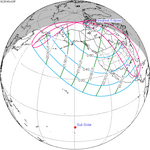 Partial (north) |
1.09078 | |
2015–2018
This eclipse is a member of a semester series. An eclipse in a semester series of solar eclipses repeats approximately every 177 days and 4 hours (a semester) at alternating nodes of the Moon's orbit.[114]
| Descending node | Ascending node | |||||
|---|---|---|---|---|---|---|
| Saros | Map | Gamma | Saros | Map | Gamma | |
120 Longyearbyen, Svalbard |
2015 March 20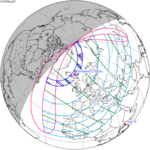 Total |
0.94536 | 125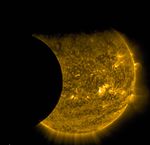 Solar Dynamics Observatory |
2015 September 13  Partial (south) |
−1.10039 | |
130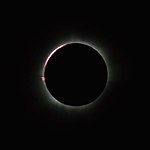 Balikpapan, Indonesia |
2016 March 9 Total |
0.26092 | 135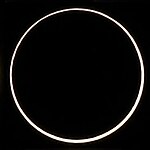 L'Étang-Salé, Réunion |
2016 September 1 Annular |
−0.33301 | |
140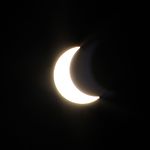 Partial from Buenos Aires |
2017 February 26 Annular |
−0.45780 | 145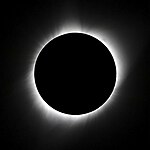 Casper, Wyoming |
2017 August 21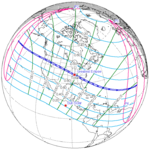 Total |
0.43671 | |
150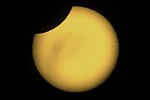 Partial from Olivos, Buenos Aires |
2018 February 15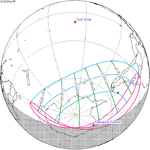 Partial (south) |
−1.21163 | 155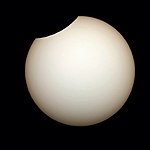 Partial from Huittinen, Finland |
2018 August 11 Partial (north) |
1.14758 | |
Partial solar eclipses on July 13, 2018, and January 6, 2019, occur during the next semester series.
2018–2021
This eclipse is a member of a semester series. An eclipse in a semester series of solar eclipses repeats approximately every 177 days and 4 hours (a semester) at alternating nodes of the Moon's orbit.[115]
Note: Partial solar eclipses on February 15, 2018, and August 11, 2018, occurred during the previous semester series.
| Ascending node | Descending node | |||||
|---|---|---|---|---|---|---|
| Saros | Map | Gamma | Saros | Map | Gamma | |
117 Partial from Melbourne, Australia |
2018 July 13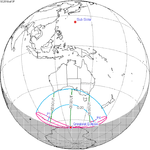 Partial |
−1.35423 | 122 Partial from Nakhodka, Russia |
2019 January 6 Partial |
1.14174 | |
127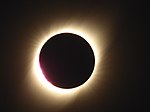 La Serena, Chile |
2019 July 2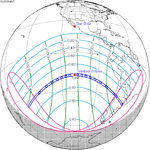 Total |
−0.64656 | 132 Jaffna, Sri Lanka
|
2019 December 26 Annular |
0.41351 | |
137 Beigang, Yunlin, Taiwan |
2020 June 21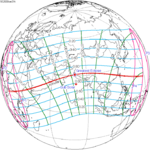 Annular |
0.12090 | 142 Gorbea, Chile |
2020 December 14 Total |
−0.29394 | |
| 147 Halifax, Canada
|
2021 June 10 Annular |
0.91516 | 152 From HMS Protector off South Georgia |
2021 December 4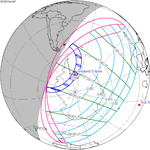 Total |
−0.95261 | |
2022–2025
This eclipse is a member of a semester series. An eclipse in a semester series of solar eclipses repeats approximately every 177 days and 4 hours (a semester) at alternating nodes of the Moon's orbit.[116]
| Solar eclipse series sets from 2022 to 2025 | ||||||
|---|---|---|---|---|---|---|
| Ascending node | Descending node | |||||
| Saros | Map | Gamma | Saros | Map | Gamma | |
119 Partial from CTIO, Chile |
2022 April 30 Partial |
−1.19008 | 124 Saratov, Russia
|
2022 October 25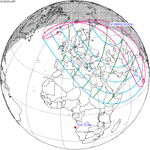 Partial |
1.07014 | |
129 Total from East Timor |
2023 April 20 Hybrid |
−0.39515 | 134 Annular from Campeche, Mexico |
2023 October 14 Annular |
0.37534 | |
| 139 USA
|
2024 April 8 Total |
0.34314 | 144 | 2024 October 2 Annular |
−0.35087 | |
| 149 | 2025 March 29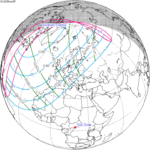 Partial |
1.04053 | 154 | 2025 September 21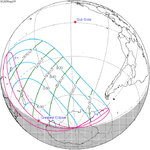 Partial |
−1.06509 | |
2026–2029
This eclipse is a member of a semester series. An eclipse in a semester series of solar eclipses repeats approximately every 177 days and 4 hours (a semester) at alternating nodes of the Moon's orbit.[117]
| Ascending node | Descending node | |||||
|---|---|---|---|---|---|---|
| Saros | Map | Gamma | Saros | Map | Gamma | |
| 121 | 2026 February 17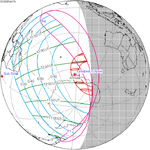 Annular |
−0.97427 | 126 | 2026 August 12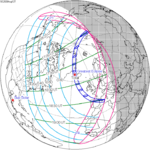 Total |
0.89774 | |
| 131 | 2027 February 6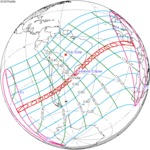 Annular |
−0.29515 | 136 | 2027 August 2 Total |
0.14209 | |
| 141 | 2028 January 26 Annular |
0.39014 | 146 | 2028 July 22 Total |
−0.60557 | |
| 151 | 2029 January 14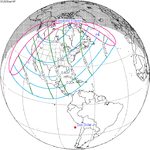 Partial |
1.05532 | 156 | 2029 July 11 Partial |
−1.41908 | |
Partial solar eclipses on June 12, 2029, and December 5, 2029, occur in the next lunar year eclipse set.
See also
- Lists of solar eclipses
- List of films featuring eclipses
- Apollo–Soyuz: First joint U.S.–Soviet space flight. Mission included an arranged eclipse of the Sun by the Apollo module to allow instruments on the Soyuz to take photographs of the solar corona.
- Eclipse chasing: Travel to eclipse locations for study and enjoyment
- Occultation: Generic term for occlusion of an object by another object that passes between it and the observer, thus revealing (for example) the presence of an exoplanet orbiting a distant star by eclipsing it as seen from Earth
- Eclipses in history and culture: treatment of solar and lunar eclipses by historical and contemporary society and religion
- Solar eclipses in fiction
- Solar eclipses on the Moon: Eclipse of the Sun by planet Earth, as seen from the Moon
- Lunar eclipse: Solar eclipse of the Moon, as seen from Earth; the shadow cast on the Moon by that eclipse
- Transit of Venus: Passage of the planet Venus between the Sun and Earth, as seen from Earth. Technically a partial eclipse.
- Transit of Deimos from Mars: Passage of the Martian moon Deimos between the Sun and Mars, as seen from Mars
- Transit of Phobos from Mars: Passage of the Martian moon Phobos between the Sun and Mars, as seen from Mars
Footnotes
- ^ The partial solar eclipses of January 4, 2011 and July 1, 2011 occurred in the previous semester series.
References
- ^ "What is an eclipse?". European Space Agency. Archived from the original on 2018-08-04. Retrieved 2018-08-04.
- ^ ISBN 978-0-19-953209-4.
- ^ Five solar eclipses occurred in 1935.NASA (September 6, 2009). "Five Millennium Catalog of Solar Eclipses". NASA Eclipse Web Site. Fred Espenak, Project and Website Manager. Archived from the original on April 29, 2010. Retrieved January 26, 2010.
- ^ Koukkos, Christina (May 14, 2009). "Eclipse Chasing, in Pursuit of Total Awe". The New York Times. Archived from the original on June 26, 2018. Retrieved January 15, 2012.
- ^ Pasachoff, Jay M. (July 10, 2010). "Why I Never Miss a Solar Eclipse". The New York Times. Archived from the original on June 26, 2018. Retrieved January 15, 2012.
- ^ a b c d e f Harrington, pp. 9–11
- ^ "Solar Eclipses". University of Tennessee. Archived from the original on June 9, 2015. Retrieved January 15, 2012.
- ^ "How Is the Sun Completely Blocked in an Eclipse?". NASA Space Place. NASA. 2009. Archived from the original on 2021-01-19. Retrieved 2019-09-01.
- ^ Steel, p. 351
- ^ Baylor University Department of Physics (2024). "What is a solar eclipse?". Baylor University. Retrieved April 12, 2024.
There are three main types of solar eclipses: Total solar eclipse, Partial solar eclipse, Annular solar eclipse
- ^ a b c "What Are the Three Types of Solar Eclipses?". Exploratorium. Retrieved 11 Oct 2023.
- ^ Harrington, pp. 7–8
- ^ "Eclipse: Who? What? Where? When? and How? | Total Solar Eclipse 2017". eclipse2017.nasa.gov. Archived from the original on 2017-09-18. Retrieved 2017-09-21.
- ^ a b Villalpando, Roberto (September 15, 2023). "October eclipse will be annular, not annual, but oversized glasses show how confusing it can be". San Antonio Express-News. Retrieved April 11, 2024.
Annular means of, relating to or forming a ring [...] it has its roots in the Latin word for ring, 'anulus'. [...] Annual, on the other hand, means occurring every year or once a year. The word also has a Latin ancestor: 'annus', which means year.
- ^ "Transit of Venus, Sun–Earth Day 2012". nasa.gov. Archived from the original on January 14, 2016. Retrieved February 7, 2016.
- ^ Espenak, Fred (September 26, 2009). "Solar Eclipses for Beginners". MrEclipse.com. Archived from the original on May 24, 2015. Retrieved January 15, 2012.
- ^ a b Espenak, Fred (January 6, 2009). "Central Solar Eclipses: 1991–2050". NASA Eclipse web site. Greenbelt, MD: NASA Goddard Space Flight Center. Archived from the original on January 8, 2021. Retrieved January 15, 2012.
- ^ Verbelen, Felix (November 2003). "Solar Eclipses on Earth, 1001 BC to AD 2500". online.be. Archived from the original on August 3, 2019. Retrieved January 15, 2012.
- ^ Harrington, pp. 13–14; Steel, pp. 266–279
- ^ Mobberley, pp. 30–38
- ^ a b c Harrington, pp. 4–5
- ^ Hipschman, Ron. "Why Eclipses Happen". Exploratorium. Archived from the original on December 27, 2015. Retrieved January 14, 2012.
- ^ Brewer, Bryan (January 14, 1998). "What Causes an Eclipse?". Earth View. Archived from the original on January 2, 2013. Retrieved January 14, 2012.
- ^ NASA – Eclipse 99 – Frequently Asked Questions Archived 2010-05-27 at the Wayback Machine – There is a mistake in the How long will we continue to be able to see total eclipses of the Sun? answer, "...the Sun's angular diameter varies from 32.7 minutes of arc when the Earth is at its farthest point in its orbit (aphelion), and 31.6 arc minutes when it is at its closest (perihelion)." It should appear smaller when farther, so the values should be swapped.
- ^ Steel, pp. 319–321
- ^ Steel, pp. 317–319
- ^ Harrington, pp. 5–7
- ^ a b Espenak, Fred (August 28, 2009). "Periodicity of Solar Eclipses". NASA Eclipse web site. Greenbelt, MD: NASA Goddard Space Flight Center. Archived from the original on November 12, 2020. Retrieved January 15, 2012.
- ^ Espenak, Fred; Meeus, Jean (January 26, 2007). "Five Millennium Catalog of Solar Eclipses: -1999 to +3000". NASA Eclipse web site. Greenbelt, MD: NASA Goddard Space Flight Center. Archived from the original on October 24, 2020. Retrieved January 15, 2012.
- ^ European Space Agency, "Spacecraft flight dynamics Archived 2019-12-11 at the Wayback Machine: proceedings of an international symposium, 18–22 May 1981 – Darmstadt, Germany", p. 347
- ^ Mobberley, pp. 33–37
- ^ "How do eclipses such as the one on Wednesday 14 November 2012 occur?". Sydney Observatory. Archived from the original on 29 April 2013. Retrieved 20 March 2015.
- ^ Steel, pp. 52–53
- ^ ISBN 978-1-891389-85-6.
- ^ Bibcode:2003JBAA..113..343M.
- ^ M. Littman, et al.
- ^ Espenak, Fred (March 24, 2008). "World Atlas of Solar Eclipse Paths". NASA Eclipse web site. NASA Goddard Space Flight Center. Archived from the original on July 14, 2012. Retrieved January 15, 2012.
- ^ Steel, p. 4
- ^ For 360 years, see Harrington, p. 9; for 410 years, see Steel, p. 31
- ^ Mobberley, pp. 33–36; Steel, p. 258
- S2CID 10644966.
- ISBN 0-521-46194-4. Archivedfrom the original on 2020-08-01. Retrieved 2012-01-04.
- ^ Mobberley, p. 10
- ^ Espenak, Fred (August 28, 2009). "Eclipses and the Saros". NASA Eclipse web site. NASA Goddard Space Flight Center. Archived from the original on May 24, 2012. Retrieved January 15, 2012.
- Bibcode:1935PA.....43..412P.
- ^ "What are solar eclipses and how often do they occur?". timeanddate.com. Archived from the original on 2017-02-02. Retrieved 2014-11-23.
- ^ a b Walker, John (July 10, 2004). "Moon near Perigee, Earth near Aphelion". Fourmilab. Archived from the original on December 8, 2013. Retrieved March 7, 2010.
- ^ Mayo, Lou. "WHAT'S UP? The Very Last Solar Eclipse!". NASA. Archived from the original on 2017-08-22. Retrieved 22 August 2017.
- ^ Espenak, Fred (July 11, 2005). "Eye Safety During Solar Eclipses". NASA Eclipse web site. NASA Goddard Space Flight Center. Archived from the original on July 16, 2012. Retrieved January 15, 2012.
- PMID 10454393.
- ^ MacRobert, Alan M. (8 August 2006). "How to Watch a Partial Solar Eclipse Safely". Sky & Telescope. Retrieved August 4, 2007.
- ^ Chou, B. Ralph (July 11, 2005). "Eye safety during solar eclipses". NASA Eclipse web site. NASA Goddard Space Flight Center. Archived from the original on November 14, 2020. Retrieved January 15, 2012.
- ^ Littmann, Mark; Willcox, Ken; Espenak, Fred (1999). "Observing Solar Eclipses Safely". MrEclipse.com. Archived from the original on July 26, 2020. Retrieved January 15, 2012.
- ^ Chou, B. Ralph (January 20, 2008). "Eclipse Filters". MrEclipse.com. Archived from the original on November 27, 2020. Retrieved January 4, 2012.
- ^ a b "Solar Viewing Safety". Perkins Observatory. Archived from the original on July 14, 2020. Retrieved January 15, 2012.
- ^ a b Harrington, p. 25
- ^ Harrington, p. 26
- ^ Harrington, p. 40
- ^ a b Littmann, Mark; Willcox, Ken; Espenak, Fred (1999). "The Experience of Totality". MrEclipse.com. Archived from the original on February 4, 2012. Retrieved January 15, 2012.
- ISBN 978-3-642-30481-1. Archivedfrom the original on 9 December 2019. Retrieved 24 August 2017.
- ^ Kelly, Pat (2017-07-06). "Umbraphile, Umbraphilia, Umbraphiles, and Umbraphiliacs – Solar Eclipse with the Sol Alliance". Solar Eclipse with the Sol Alliance. Archived from the original on 2019-08-13. Retrieved 2017-08-24.
- ^ "How to View the 2017 Solar Eclipse Safely". eclipse2017.nasa.gov. Archived from the original on 2017-08-24. Retrieved 2017-08-24.
- ^ Wright, Andy (2017-08-16). "Chasing Totality: A Look Into the World of Umbraphiles". Atlas Obscura. Archived from the original on 2020-12-14. Retrieved 2017-08-24.
- ^ Weitering, Hanneke (2017-07-28). "1st Photo of a Total Solar Eclipse Was Taken 166 Years Ago Today". Space.com. Retrieved 2024-04-08.
- ^ Farber, Madeline (2017-08-11). "This Is the First-Ever Photo of a Total Solar Eclipse". TIME. Retrieved 2024-04-09.
- ^ Kramer, Bill. "Photographing a Total Solar Eclipse". Eclipse-chasers.com. Archived from the original on January 29, 2009. Retrieved March 7, 2010.
- B&H Photo Video. Archivedfrom the original on July 1, 2019. Retrieved August 19, 2017.
- ^ Acta Eruditorum. Leipzig. 1762. p. 168. Archived from the original on 2020-07-31. Retrieved 2018-06-06.
- ^ "Solar Physics Historical Timeline (1223 BC – 200 BC) | High Altitude Observatory". www2.hao.ucar.edu. Retrieved 2023-12-14.
- ^ Smith, Kiona N. "People Recorded A Total Solar Eclipse For The First Time 3,241 Years Ago". Forbes. Retrieved 2023-12-14.
- ^ van Gent, Robert Harry. "Astronomical Chronology". University of Utrecht. Archived from the original on July 28, 2020. Retrieved January 15, 2012.
- ^ Harrington, p. 2
- ^ Blakeslee, Sandra (November 14, 2006). "Ancient Crash, Epic Wave". The New York Times. Archived from the original on April 11, 2009. Retrieved November 14, 2006.
- ^ Steel, p. 1
- ^ Steel, pp. 84–85
- ^ Le Conte, David (December 6, 1998). "Eclipse Quotations". MrEclipse.com. Archived from the original on October 17, 2020. Retrieved January 8, 2011.
- ^ Herodotus. Book VII. p. 37. Archived from the original on 2008-08-19. Retrieved 2008-07-13.
- ^ Chambers, G. F. (1889). A Handbook of Descriptive and Practical Astronomy. Oxford: Clarendon Press. p. 323.
- ^ a b c d e Espenak, Fred. "Solar Eclipses of Historical Interest". NASA Eclipse web site. NASA Goddard Space Flight Center. Archived from the original on March 9, 2008. Retrieved December 28, 2011.
- ^ Herodotus. Book IX. p. 10. Archived from the original on 2020-07-26. Retrieved 2008-07-14.
- Bibcode:1994S&T....87...36S.
- ^ Bibcode:1982SciAm.247d.154S.
- OCLC 48999277.
- S2CID 4360560.
- ISBN 978-0-691-05823-8.
- ^ Ó Cróinín, Dáibhí (13 May 2020). "Reeling in the years: why 664 AD was a terrible year in Ireland". rte.ie. Archived from the original on 2021-01-08. Retrieved January 9, 2021.
- ^ "Translation of Sahih Bukhari, Book 18".
- ^ Regis Morelon (1996). "General survey of Arabic astronomy". In Roshdi Rashed (ed.). Encyclopedia of the History of Arabic Science. Vol. I. Routledge. p. 15.
- ^ Fiske, John (1997). Myths and Myth-Makers Old Tales and Superstitions Interpreted by Comparative Mythology. Archived from the original on July 26, 2020. Retrieved February 12, 2017 – via Project Gutenberg.
- ^ "The science of eclipses". ESA. September 28, 2004. Archived from the original on August 1, 2012. Retrieved August 4, 2007.
- ^ Dravins, Dainis. "Flying Shadows". Lund Observatory. Archived from the original on July 26, 2020. Retrieved January 15, 2012.
- ^ Johnson-Groh, Mara (10 August 2017). "Five Tips from NASA for Photographing the Total Solar Eclipse on Aug. 21". NASA. Archived from the original on 18 August 2020. Retrieved 21 September 2017.
- from the original on November 3, 2020. Retrieved August 27, 2019.
- ^ "Relativity and the 1919 eclipse". ESA. September 13, 2004. Archived from the original on October 21, 2012. Retrieved January 11, 2011.
- ^ Steel, pp. 114–120
- ^ Allais, Maurice (1959). "Should the Laws of Gravitation be Reconsidered?". Aero/Space Engineering. 9: 46–55.
- .
- S2CID 6846335.
- S2CID 118497439.
- Bibcode:2004JBAA..114..132M. Archived from the original(PDF) on July 10, 2007.
- ISBN 978-0387742854.
- ^ "ISS-Venustransit". astronomie.info (in German). Archived from the original on 2020-07-28. Retrieved 2004-07-29.
- ^ "JSC Digital Image Collection". NASA Johnson Space Center. January 11, 2006. Archived from the original on February 4, 2012. Retrieved January 15, 2012.
- ^ Nemiroff, R.; Bonnell, J., eds. (August 30, 1999). "Looking Back on an Eclipsed Earth". Astronomy Picture of the Day. NASA. Retrieved January 15, 2012.
- ^ "Solar Eclipse 2015 – Impact Analysis Archived 2017-02-21 at the Wayback Machine" pp. 3, 6–7, 13. European Network of Transmission System Operators for Electricity, 19 February 2015. Accessed: 4 March 2015.
- ^ "Curve of potential power loss". ing.dk. Archived from the original on 2020-07-28. Retrieved 2015-03-04.
- from the original on 2015-03-04. Retrieved 2015-03-04.
- ^ Young, Alex. "How Eclipses Work". NASA. Archived from the original on 2017-09-18. Retrieved 21 September 2017.
- ^ van Gent, R.H. "Solar- and Lunar-Eclipse Predictions from Antiquity to the Present". A Catalogue of Eclipse Cycles. Utrecht University. Retrieved 6 October 2018.
- ^ van Gent, R.H. "Solar- and Lunar-Eclipse Predictions from Antiquity to the Present". A Catalogue of Eclipse Cycles. Utrecht University. Retrieved 6 October 2018.
- ^ van Gent, R.H. "Solar- and Lunar-Eclipse Predictions from Antiquity to the Present". A Catalogue of Eclipse Cycles. Utrecht University. Retrieved 6 October 2018.
- ^ van Gent, R.H. "Solar- and Lunar-Eclipse Predictions from Antiquity to the Present". A Catalogue of Eclipse Cycles. Utrecht University. Retrieved 6 October 2018.
- ^ van Gent, R.H. "Solar- and Lunar-Eclipse Predictions from Antiquity to the Present". A Catalogue of Eclipse Cycles. Utrecht University. Retrieved 6 October 2018.
- ^ van Gent, R.H. "Solar- and Lunar-Eclipse Predictions from Antiquity to the Present". A Catalogue of Eclipse Cycles. Utrecht University. Retrieved 6 October 2018.
- ^ van Gent, R.H. "Solar- and Lunar-Eclipse Predictions from Antiquity to the Present". A Catalogue of Eclipse Cycles. Utrecht University. Retrieved 6 October 2018.
- ^ van Gent, R.H. "Solar- and Lunar-Eclipse Predictions from Antiquity to the Present". A Catalogue of Eclipse Cycles. Utrecht University. Retrieved 6 October 2018.
- ^ van Gent, R.H. "Solar- and Lunar-Eclipse Predictions from Antiquity to the Present". A Catalogue of Eclipse Cycles. Utrecht University. Retrieved 6 October 2018.
Bibliography
- Mucke, Hermann; Meeus, Jean (1992). Canon of Solar Eclipses −2003 to +2526 (2 ed.). Vienna: Astronomisches Büro.
- Harrington, Philip S. (1997). Eclipse! The What, Where, When, Why and How Guide to Watching Solar and Lunar Eclipses. New York: John Wiley and Sons. ISBN 0-471-12795-7.
- ISBN 0-7472-7385-5.
- Mobberley, Martin (2007). Total Solar Eclipses and How to Observe Them. Astronomers' Observing Guides. New York: Springer. ISBN 978-0-387-69827-4.
- ISBN 978-1-941983-02-7.
- Espenak, Fred (2016). 21st Century Canon of Solar Eclipses. Portal AZ: Astropixels Publishing. ISBN 978-1-941983-12-6.
- Fotheringham, John Knight (1921). Historical eclipses: being the Halley lecture delivered 17 May 1921. Oxford: Clarendon Press.
External links
- NASA Eclipse Web Site, with information on future eclipses and eye safety information
- NASA Eclipse Web Site (older version)
- Eclipsewise, Fred Espenak's new eclipse site
- Andrew Lowe's Eclipse Page, with maps and circumstances for 5000 years of solar eclipses
- A Guide to Eclipse Activities for Educators, Explaining eclipses in educational settings
- Detailed eclipse explanations and predictions, Hermit Eclipse
- Eclipse Photography, Prof. Miroslav Druckmüller
- Animated maps of August 21, 2017 solar eclipses, Larry Koehn
- Five Millennium (−1999 to +3000) Canon of Solar Eclipses Database, Xavier M. Jubier
- Animated explanation of the mechanics of a solar eclipse Archived 2013-05-25 at the Wayback Machine, University of South Wales
- Eclipse Image Gallery Archived 2016-10-15 at the Wayback Machine, The World at Night
- Ring of Fire Eclipse: 2012, Photos
- . Collier's New Encyclopedia. 1921.
- Centered and aligned video recording of Total Solar Eclipse 20th March 2015 on YouTube
- Solar eclipse photographs taken from the Lick Observatory from the Lick Observatory Records Digital Archive, UC Santa Cruz Library’s Digital Collections Archived 2020-06-05 at the Wayback Machine
- Video with Total Solar Eclipse March 09 2016 (from the beginning to the total phase) on YouTube
- Total Solar Eclipse Shadow on Earth March 09 2016 CIMSSSatelite
- List of all solar eclipses
- National Geographic Solar Eclipse 101 video Archived 2018-08-04 at the Wayback Machine
 Wikiversity has a solar eclipse lab that students can do on any sunny day.
Wikiversity has a solar eclipse lab that students can do on any sunny day.






